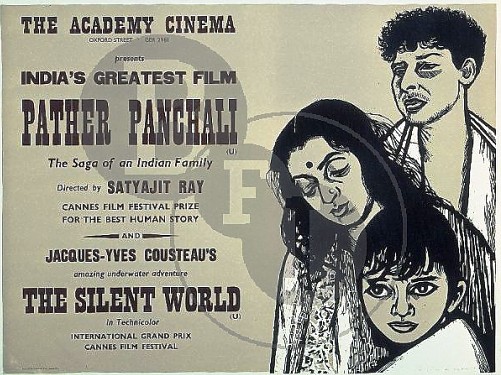Although this the latest movie i watched recently, but it left me amazed with it's sheer depth and beauty of narrative. It was as if you sketch verses of Rabindra Nath Tagore over canvas of Premchand's prose and then add the colors from Jean Paul Sartre existentialism.
Rating - 5/5
Review :
Pather Panchali feels as real as life itself.It is a narrative of life par excellence as the protagonist of movie is no character but rather life itself which i wonder "what cinema, at its best, is capable of achieving".
It's a quiet, simple tale, centering on the life of a small family living in a rural village in Bengal. The father, Harihar (Kanu Bannerjee), is a priest and poet who cares more about his writing and spiritual welfare than obtaining wages he is owed. The mother, Sarbojaya (Karuna Bannerjee), worries that her husband's financial laxity will leave her without enough food for her two children, daughter Durga (Uma Das Gupta) and son Apu (Subir Bannerjee).
 |
| Satyajit Ray |
Most of what transpires is shown through the eyes of either Sarbojaya or Durga, and, as a result, we identify most closely with these two. Harihar is absent for more than half of the movie, and just returns before the penultimate scene, Apu is a mere witness to events, rather than a participant. Until the closing moments, we don't get a sense of the young boy as a fully formed individual, since he's always in someone else's shadow.
"Pather Panchali" turns everyday childhood occurrences into wondrous events, whether it is brother and sister crossing the fields filled with white feathery rushes to see a train in the distance, a pursuit of the candy man, a Hindu feast, the wonders of the natural world, an old aunt telling bedtime stories to children. Death interrupts the family twice, taking away young Durga too. The scene in which the long-absent father returns to learn the death of his daughter is a lacerating wail from the beyond. Apu's concealing forever the suddenly-learned truth of a secret theft by his sister is a moment, once seen, can never be forgotten. In sadness, mother, father, young son move away. The film ends.
Narrative provides ample scope of character development as a result of which as movie progress audience is bound to create a deep emotional bond with them so much so that death of a character appears and feels like a personal loss. Death sequences in the movie were so hunting that leaves it's audience deeply wounded. I am not the sort of person who feels like crying during movies, but this one had me weeping like a child.
Cinematography like narrative livens up the surroundings and just takes the whole experience to another level. here ray doesn't miss any details, whether it's stray dogs, white feathery fields, forests, curious apu or the devastatingly melancholic eyes of aunt indir.
Similarly ray was also able to capture some magic moments in the movie -------
one where brother and sister crossing the fields filled with white feathery rushes to see a train in the distance,
then their pursuit of the candy man, death of durga,
and the most powerful- Apu's concealing forever the suddenly-learned truth of a secret theft by his sister.
Background score by pt. Ravishankar is true to narrative and sitar in background just adds to the poetic value of movie.
 Final Thoughts :This is apu's family world and Ray lets us see it through their eyes. Akira Kurasawa called Ray a genius and we guess we could say, it took one to know one.
Final Thoughts :This is apu's family world and Ray lets us see it through their eyes. Akira Kurasawa called Ray a genius and we guess we could say, it took one to know one.This movie proves beyond doubt that neo-realism could have emerged in Italy but it was in no way limited to Italy. Ray was a global artist and his art sparked thousands of fire and flash in hearts of young artists.


Let then come,
ReplyDeleteplease cover more on Indian Cinema
i love the effort and your Blog....